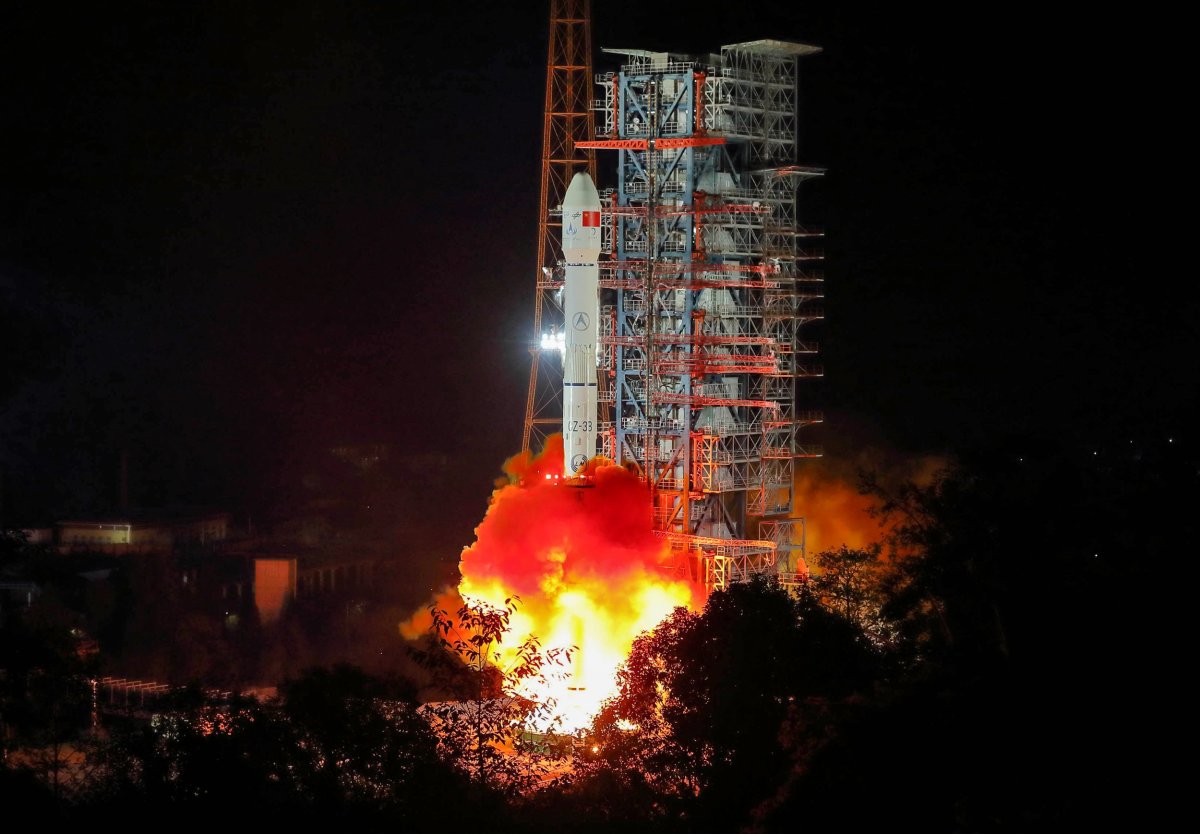China has landed a spacecraft on the far side of the moon in a world first, according to state-run media. The uncrewed Chang'e-4 lander and rover successfully arrived in the Von Karman crater, which is within the South Pole-Aitken Basin, at 10:26 a.m. Beijing time on Thursday, according to Chinese broadcaster CGTN.
After it touched down, the spacecraft took the first photo of what is widely known as the "dark side" of the moon, and sent it back to Earth via the Queqiao (Magpie Bridge) satellite. The satellite, which launched last May, is orbiting the second Lagrangian point of the Earth-moon system.
#China's Chang'e-4 probe sends back world's first close shot of moon's far side after historic soft landing on uncharted area https://t.co/OckokVjnh8 pic.twitter.com/ReORkkPcq3
— CGTN (@CGTNOfficial) January 3, 2019
Now that it has landed, the Chang'e-4 is tasked with collecting data on the far side of the moon, including on the structure of its surface and its mantle, as well as its minerals, according to CGTN. It will also carry out low-frequency astronomical observations because it is shielded from radio interference.
"So far what we know about the far side of the moon is from orbiters only, from Russia, the U.S., Europe, China and India," Andrew Coates, Professor of Physics at University College London, U.K., told Newsweek.
The Aitken Basin where Chang'e-4 is located is around 4.2 billion years old, and measures 2,500 kilometers in diameter and sits 13 kilometers deep. That makes it one of the largest and oldest impact basins in the Solar System, Dr. Mahesh Anand, reader in Planetary Science and Exploration at The Open University, U.K., told Newsweek.
The basin could have breached the lunar crust, exposing the mantle below, he explained. "This could be our only direct view of the lunar interior—important for understanding the chemical and thermal evolution of the Moon."
The China National Space Administration agency launched Chang'e-4 in December from its center in Xichang, southwest China. Landing the vessel, named after Chang'e, the goddess of the moon in Chinese mythology, was no easy feat. While the near side of the moon is dotted with flat areas that spacecraft can land on with relative ease, the far side is covered in craters. Some of its mountains are higher than Mount Everest, Earth's highest mountain above sea level, Anand said.
In addition, this part of the moon is not visible from Earth due to a phenomenon known as tidal locking. This occurs because it takes the moon 28 days to orbit Earth, and 28 days to spin once on its axis, meaning the same side always faces our planet. As it is not possible to shoot signals to the far side of the moon, China launched the Queqiao satellite so it could provide a point of contact for Chang'e-4.
On top of that, Chinese scientists had to create a rover that could work in extreme temperatures. At the height of day, temperatures can hit around 260 degrees Fahrenheit, but plummet to around -280 Fahrenheit at night.
David Rothery, professor of planetary geosciences at the Open University, U.K., highlighted in a piece for The Conversation that only the U.S. and Soviet Union had landed spacecraft on the moon, in missions steered by humans or that "relied on luck for a safe landing."
"Chang'e-4 used a downward-looking camera and hazard avoidance software to steer itself to a flat and sufficiently boulder-free landing spot as it slowed its descent using retrorockets—an impressive technological feat," he wrote.
However, Rothery told Newsweek: "I'm not expecting a lot of important science from this landing. For example, the chemical and mineralogicalanalyses of the rocks will be pretty basic. It's a stepping stone to Chinese sample return missions and crewed landings."
Anand, meanwhile, was optimistic about how Chang'e-4 will contribute to our wider understanding of this area of research. "It will not be surprising if the future exploration of the lunar farside, heralded by the Chang'e-4 landing, could necessitate a paradigm shift in our understanding of planetary formation in our Solar System and potentially other exoplanetary systems as well," he said.
Coates argued the launch of the rover "illustrates China's commitment to space exploration."
The project is the latest chapter in Beijing's billion-dollar space program. It comes after the launch of the Yutu (Jade Rabbit) rover in 2013 as part of the Chang'e-3 lander mission. It spent 31 months exploring the moon, and discovered evidence of ancient lava plains beneath the satellite's crust, New Scientist reported.
China also has ambitions to have a crewed space station by 2022. Yang Liwei, deputy director of China's Manned Space Agency, said in March 2018 that the separate parts of the T-shaped station would be launched and assembled in orbit, according to SpaceTechAsia.

This article has been updated with background information and comment from David Rothery, Mahesh Anand and Andrew Coates.
Uncommon Knowledge
Newsweek is committed to challenging conventional wisdom and finding connections in the search for common ground.
Newsweek is committed to challenging conventional wisdom and finding connections in the search for common ground.
About the writer
Kashmira Gander is Deputy Science Editor at Newsweek. Her interests include health, gender, LGBTQIA+ issues, human rights, subcultures, music, and lifestyle. Her ... Read more
To read how Newsweek uses AI as a newsroom tool, Click here.








